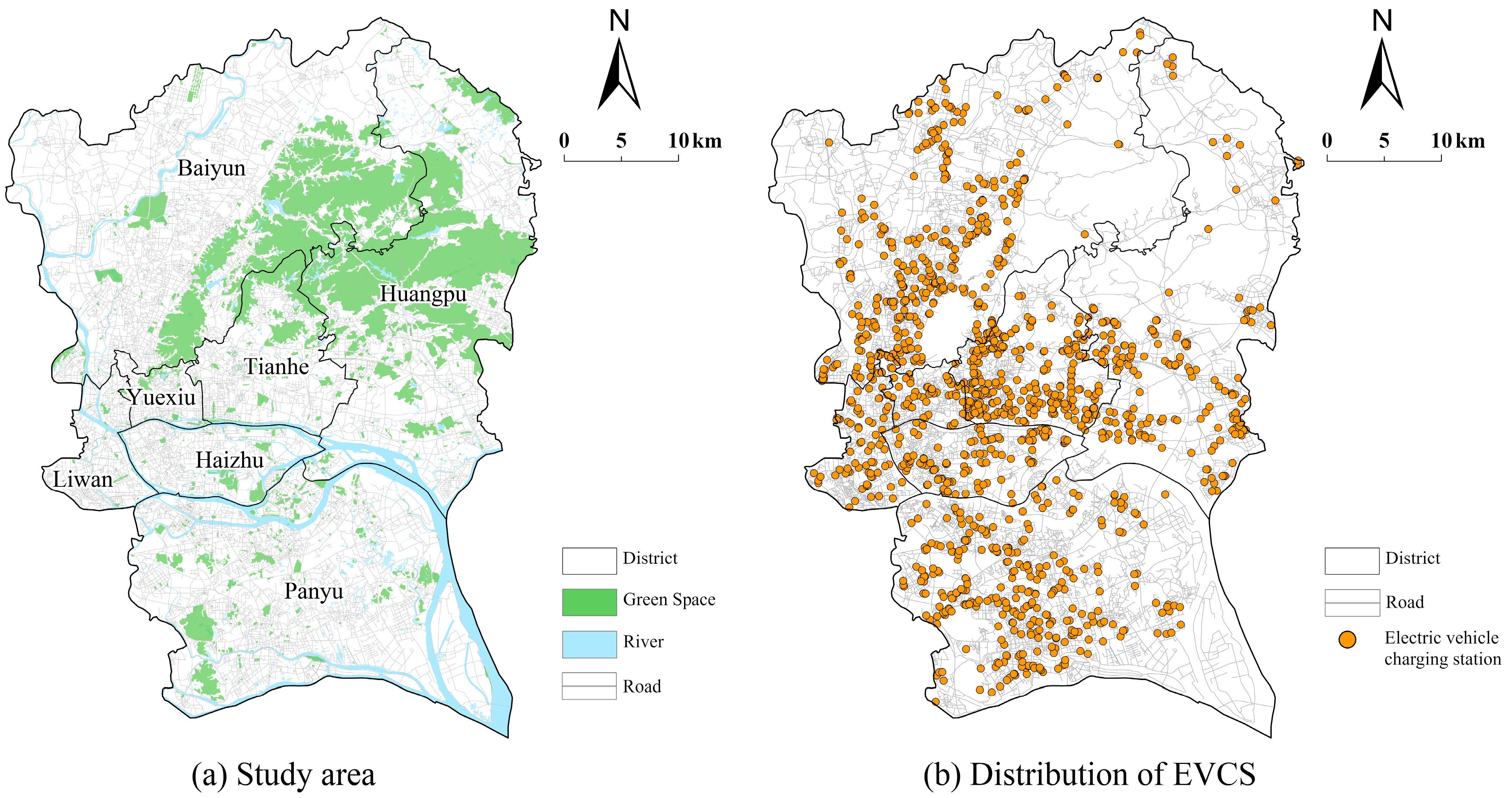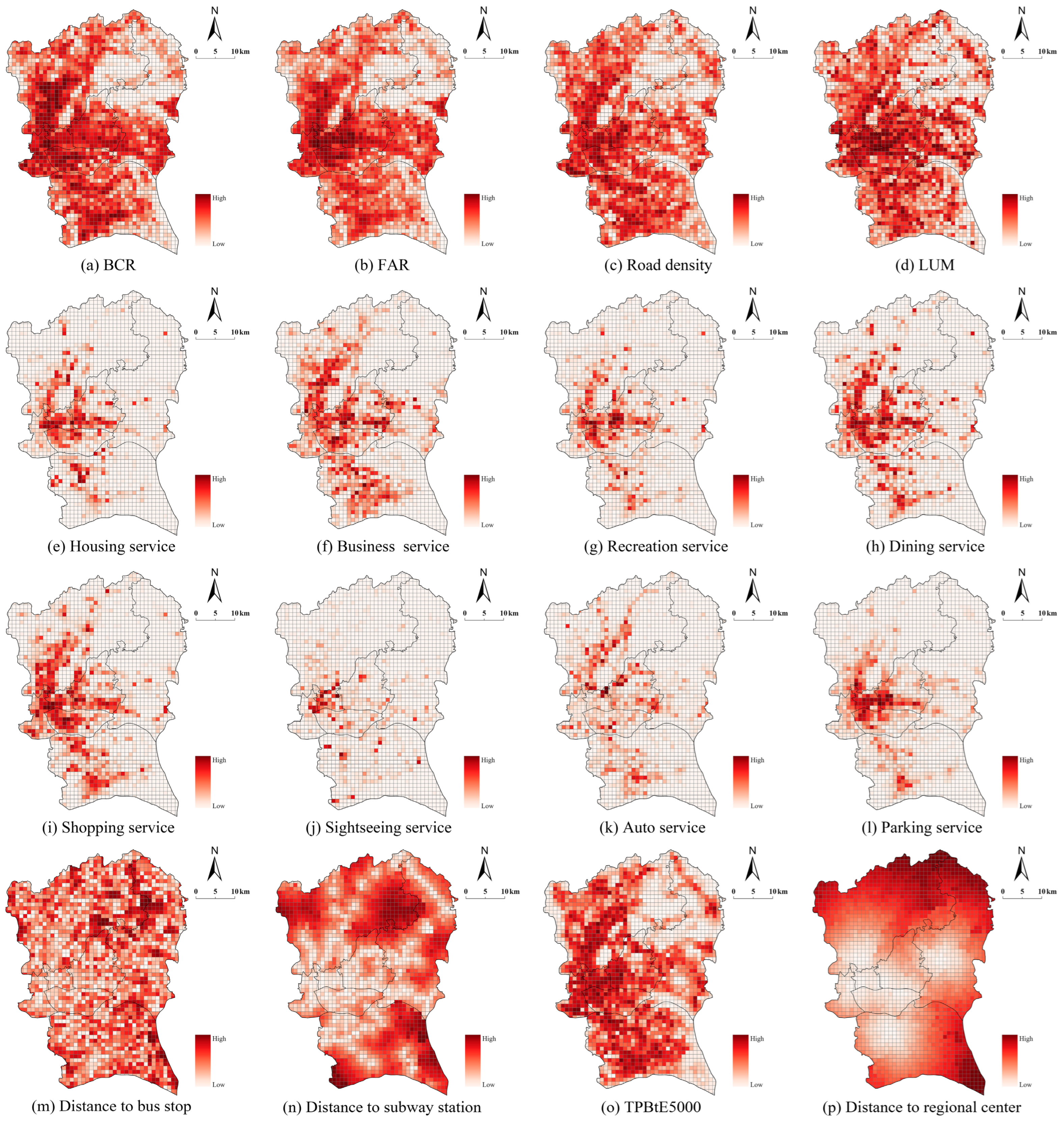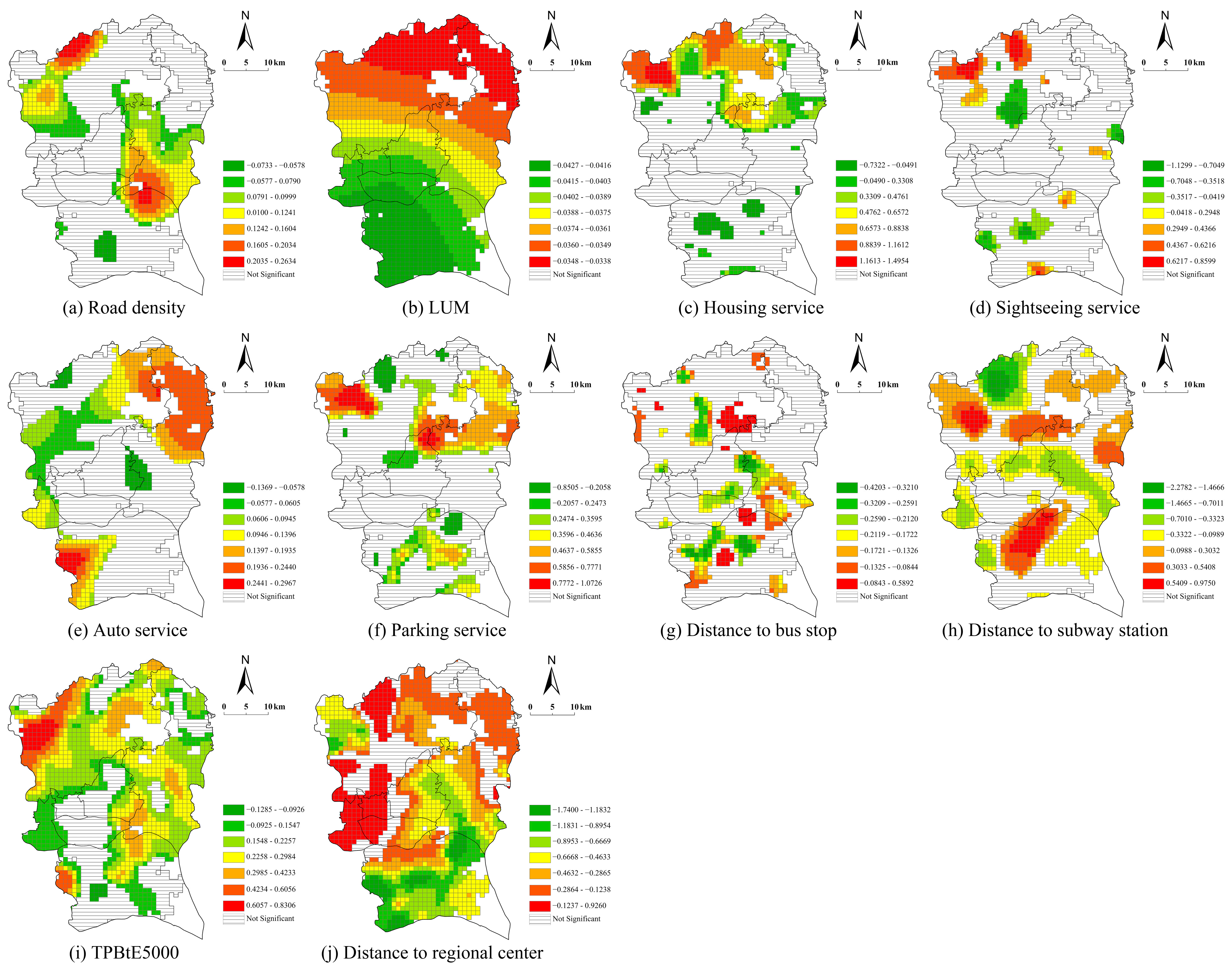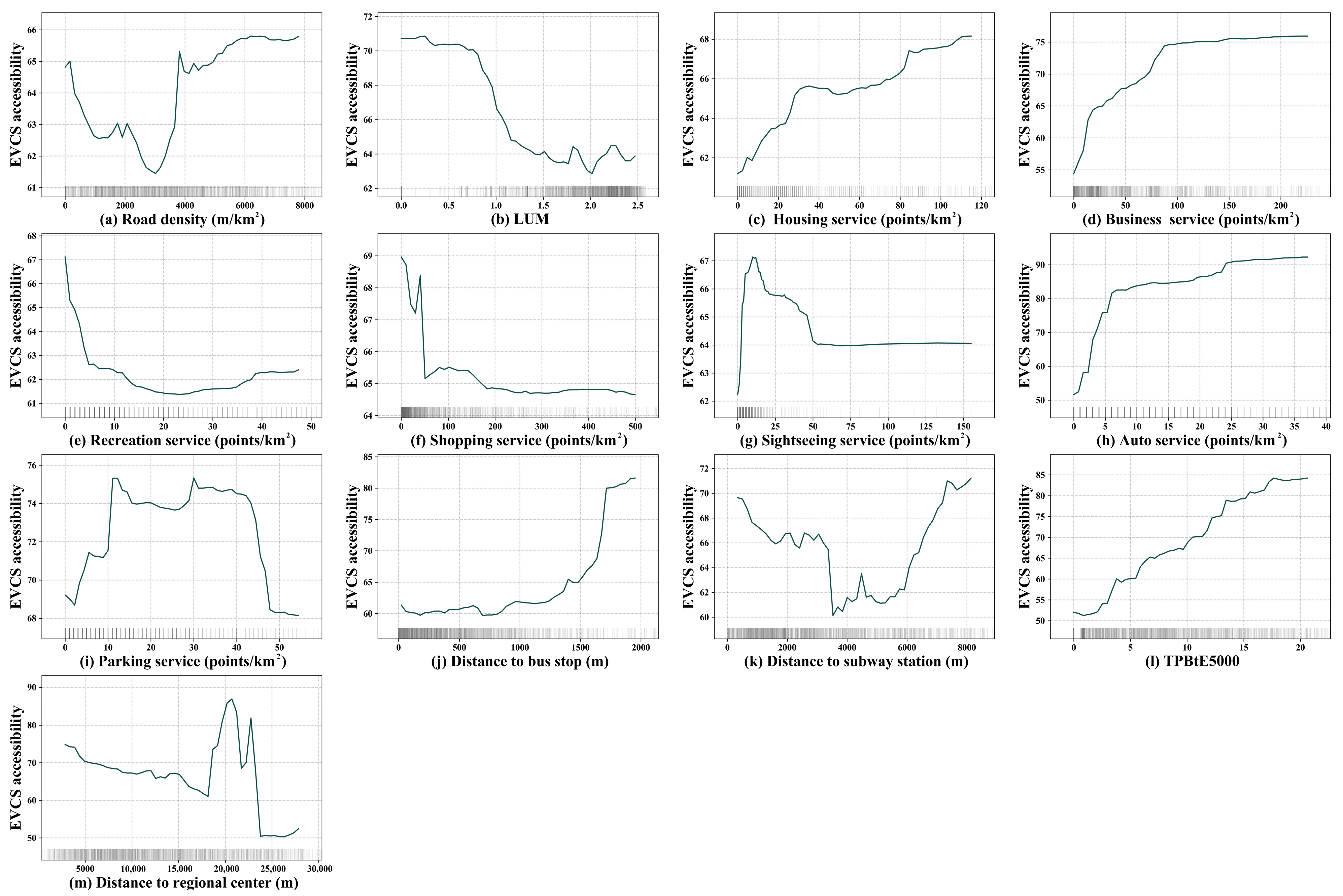How Does the Urban Built Environment Affect the Accessibility of Public Electric-Vehicle Charging Stations? A Perspective on Spatial Heterogeneity and a Non-Linear Relationship
Abstract
:1. Introduction
2. Literature Review
3. Materials and Methods
3.1. Study Framework
3.2. Study Area and Data
3.3. Variables
3.3.1. Dependent Variables
3.3.2. Independent Variables
3.4. Method
3.4.1. Gaussian Two-Step Floating Catchment Area (G2SFCA)
3.4.2. Multiscale Geographically Weighted Regression (MGWR)
3.4.3. Random Forest Model
4. Results
4.1. Spatial Differences of EVCS Accessibility
4.1.1. Spatial Distribution Characteristics
4.1.2. Spatial Clustering Characteristics
4.2. The Results of MGWR
4.2.1. Spatial Autocorrelation of Built Environment
4.2.2. Analysis of Spatial Heterogeneity of Variables Influencing EVCS Accessibility
4.3. The Results of the RF Model
4.3.1. Model Performance
4.3.2. Relative Importance of Built Environment
4.3.3. Joint Analysis of Spatial Heterogeneity and Non-Linear Relationship
- (1)
- Density
- (2)
- Diversity
- (3)
- Land use
- (4)
- Distance to transit
- (5)
- Destination accessibility
5. Discussion
6. Conclusions
Author Contributions
Funding
Institutional Review Board Statement
Informed Consent Statement
Data Availability Statement
Conflicts of Interest
References
- Wang, J.; Xu, C.; Pauleit, S.; Kindler, A.; Banzhaf, E. Spatial patterns of urban green infrastructure for equity: A novel exploration. J. Clean. Prod. 2019, 238, 117858. [Google Scholar] [CrossRef]
- Global EV Outlook 2024. Available online: https://www.iea.org/reports/global-ev-outlook-2024 (accessed on 11 October 2024).
- Funke, S.Á.; Sprei, F.; Gnann, T.; Plötz, P. How much charging infrastructure do electric vehicles need? A review of the evidence and international comparison. Transp. Res. Part D Transp. Environ. 2019, 77, 224–242. [Google Scholar] [CrossRef]
- Liu, J. Electric vehicle charging infrastructure assignment and power grid impacts assessment in Beijing. Energy Policy 2012, 51, 544–557. [Google Scholar] [CrossRef]
- Patil, P.; Kazemzadeh, K.; Bansal, P. Integration of charging behavior into infrastructure planning and management of electric vehicles: A systematic review and framework. Sustain. Cities Soc. 2023, 88, 104265. [Google Scholar] [CrossRef]
- Zhang, Y.; Zhang, Q.; Farnoosh, A.; Chen, S.; Li, Y. GIS-based multi-objective particle swarm optimization of charging stations for electric vehicles. Energy 2019, 169, 844–853. [Google Scholar] [CrossRef]
- Peng, Z.; Wang, M.W.H.; Yang, X.; Chen, A.; Zhuge, C. An analytical framework for assessing equitable access to public electric vehicle chargers. Transp. Res. Part D Transp. Environ. 2024, 126, 103990. [Google Scholar] [CrossRef]
- Zhang, Y.; Kamargianni, M.; Cheng, L.; De Vos, J.; Cao, M. Evaluating the accessibility of on-street household electric vehicle charging stations in London: Policy insights from equity analysis across emission zones. Energy Policy 2024, 195, 114375. [Google Scholar] [CrossRef]
- Hsu, C.W.; Fingerman, K. Public electric vehicle charger access disparities across race and income in California. Transp. Policy 2021, 100, 59–67. [Google Scholar] [CrossRef]
- Ma, R.; Huang, A.; Cui, H.; Yu, R.; Peng, X. Spatial heterogeneity analysis on distribution of intra-city public electric vehicle charging points based on multi-scale geographically weighted regression. Travel Behav. Soc. 2024, 35, 100725. [Google Scholar] [CrossRef]
- Roy, A.; Law, M. Examining spatial disparities in electric vehicle charging station placements using machine learning. Sustain. Cities Soc. 2022, 83, 103978. [Google Scholar] [CrossRef]
- Kang, J.; Kong, H.; Lin, Z.; Dang, A. Mapping the dynamics of electric vehicle charging demand within Beijing’s spatial structure. Sustain. Cities Soc. 2022, 76, 103507. [Google Scholar] [CrossRef]
- Shuai, C.; Zhang, X.; Ouyang, X.; Liu, K.; Yang, Y. Research on charging demands of commercial electric vehicles based on Voronoi diagram and spatial econometrics model: An empirical study in Chongqing China. Sustain. Cities Soc. 2024, 105, 105335. [Google Scholar] [CrossRef]
- Pemberton, S.; Nobajas, A.; Waller, R. Rapid charging provision, multiplicity and battery electric vehicle (BEV) mobility in the UK. J. Transp. Geogr. 2021, 95, 103137. [Google Scholar] [CrossRef]
- Machado, C.A.S.; Takiya, H.; Yamamura, C.L.K.; Quintanilha, J.A.; Berssaneti, F.T. Placement of infrastructure for urban electromobility: A sustainable approach. Sustainability 2020, 12, 6324. [Google Scholar] [CrossRef]
- Yi, T.; Zhang, C.; Lin, T.; Liu, J. Research on the spatial-temporal distribution of electric vehicle charging load demand: A case study in China. J. Clean. Prod. 2020, 242, 118457. [Google Scholar] [CrossRef]
- Pan, L.; Yao, E.; Yang, Y.; Zhang, R. A location model for electric vehicle (EV) public charging stations based on drivers’ existing activities. Sustain. Cities Soc. 2020, 59, 102192. [Google Scholar] [CrossRef]
- Bilsel, M.; Kilic, H.S.; Kalender, Z.T.; Tuzkaya, G. Multi-objective model for electric vehicle charging station location selection problem for a sustainable transportation infrastructure. Comput. Ind. Eng. 2024, 198, 110695. [Google Scholar] [CrossRef]
- Wu, T.; Fainman, E.; Maïzi, Y.; Shu, J.; Li, Y. Allocate electric vehicles’ public charging stations with charging demand uncertainty. Transp. Res. Part D Transp. Environ. 2024, 130, 104178. [Google Scholar] [CrossRef]
- Algafri, M.; Alghazi, A.; Almoghathawi, Y.; Saleh, H.; Al-Shareef, K. Smart City Charging Station allocation for electric vehicles using analytic hierarchy process and multiobjective goal-programming. Appl. Energy 2024, 372, 123775. [Google Scholar] [CrossRef]
- Razeghi, M.; Roghani Araghi, A.; Naseri, A.; Yousefi, H. Strategic deployment of GIS-optimized solar charging stations for electric vehicles: A multi-criteria decision-making approach. Energy Convers. Manag. X 2024, 24, 100712. [Google Scholar] [CrossRef]
- Li, G.; Luo, T.; Song, Y. Spatial equity analysis of urban public services for electric vehicle charging—Implications of Chinese cities. Sustain. Cities Soc. 2022, 76, 103519. [Google Scholar] [CrossRef]
- Chen, Y.; Yu, P.; Li, Z.; Wang, J.; Chen, Y. Equity measurement of urban green space environment based on SDG11—A case study of Wuhan city central area. Geogr. Geo-Inf. Sci. 2021, 37, 81–89. [Google Scholar]
- Nicholas, M.; Tal, G.; Ji, W. Lessons from in-use Fast Charging Data: Why are Drivers Staying Close to Home. Available online: https://itspubs.ucdavis.edu/download_pdf.php?id=2699 (accessed on 12 October 2024).
- Tahmasbi, B.; Mansourianfar, M.H.; Haghshenas, H.; Kim, I. Multimodal accessibility-based equity assessment of urban public facilities distribution. Sustain. Cities Soc. 2019, 49, 101633. [Google Scholar] [CrossRef]
- Kelobonye, K.; McCarney, G.; Xia, J.; Swapan, M.S.H.; Mao, F.; Zhou, H. Relative accessibility analysis for key land uses: A spatial equity perspective. J. Transp. Geogr. 2019, 75, 82–93. [Google Scholar] [CrossRef]
- Cai, Y.; Zhang, J.; Gu, Q.; Wang, C. An analytical framework for assessing equity of access to public electric vehicle charging stations: The case of Shanghai. Sustainability 2024, 16, 6196. [Google Scholar] [CrossRef]
- Falchetta, G.; Noussan, M. Electric vehicle charging network in Europe: An accessibility and deployment trends analysis. Transp. Res. Part D Transp. Environ. 2021, 94, 102813. [Google Scholar] [CrossRef]
- Esmaili, A.; Oshanreh, M.M.; Naderian, S.; MacKenzie, D.; Chen, C. Assessing the spatial distributions of public electric vehicle charging stations with emphasis on equity considerations in King County, Washington. Sustain. Cities Soc. 2024, 107, 105409. [Google Scholar] [CrossRef]
- Carlton, G.J.; Sultana, S. Electric vehicle charging equity and accessibility: A comprehensive United States policy analysis. Transp. Res. Part D Transp. Environ. 2024, 129, 104123. [Google Scholar] [CrossRef]
- Gazmeh, H.; Guo, Y.; Qian, X. Understanding the opportunity-centric accessibility for public charging infrastructure. Transp. Res. Part D Transp. Environ. 2024, 131, 104222. [Google Scholar] [CrossRef]
- Carlton, G.J.; Sultana, S. Electric vehicle charging station accessibility and land use clustering: A case study of the Chicago region. J. Urban Mobil. 2022, 2, 100019. [Google Scholar] [CrossRef]
- Park, J.; Kang, J.-Y.; Goldberg, D.W.; Hammond, T.A. Leveraging temporal changes of spatial accessibility measurements for better policy implications: A case study of electric vehicle (EV) charging stations in Seoul, South Korea. Int. J. Geogr. Inf. Sci. 2022, 36, 1185–1204. [Google Scholar] [CrossRef]
- Khan, H.A.U.; Price, S.; Avraam, C.; Dvorkin, Y. Inequitable access to EV charging infrastructure. Electr. J. 2022, 35, 107096. [Google Scholar] [CrossRef]
- Oshan, T.M.; Li, Z.; Kang, W.; Wolf, L.J.; Fotheringham, A.S. mgwr: A python implementation of multiscale geographically weighted regression for investigating process spatial heterogeneity and scale. ISPRS Int. J. Geo-Inf. 2019, 8, 269. [Google Scholar] [CrossRef]
- Fotheringham, A.S.; Yang, W.; Kang, W. Multiscale geographically weighted regression (MGWR). Ann. Am. Assoc. Geogr. 2017, 107, 1247–1265. [Google Scholar] [CrossRef]
- Li, Z. Extracting spatial effects from machine learning model using local interpretation method: An example of SHAP and XGBoost. Comput. Environ. Urban Syst. 2022, 96, 101845. [Google Scholar] [CrossRef]
- 2023 Guangzhou National Economic and Social Development Statistical Bulletin. Available online: https://tjj.gz.gov.cn/stats_newtjyw/tjsj/tjgb/qstjgb/content/mpost_9567759.html (accessed on 12 October 2024).
- Guangzhou Three-Year Action Plan for Accelerating the Construction of Electric Vehicle Charging Infrastructure (2022–2024). Available online: https://gxj.gz.gov.cn/yw/zcjd/content/post_8587269.html (accessed on 12 October 2024).
- Weiss, D.J.; Nelson, A.; Gibson, H.S.; Temperley, W.; Peedell, S.; Lieber, A.; Hancher, M.; Poyart, E.; Belchior, S.; Fullman, N.; et al. A global map of travel time to cities to assess inequalities in accessibility in 2015. Nature 2018, 553, 333–336. [Google Scholar] [CrossRef]
- Chen, Y.; Xu, C.; Ge, Y.; Zhang, X.; Zhou, Y. A 100 m gridded population dataset of China’s seventh census using ensemble learning and big geospatial data. Earth Syst. Sci. Data 2024, 16, 3705–3718. [Google Scholar] [CrossRef]
- Che, Y.; Li, X.; Liu, X.; Wang, Y.; Liao, W.; Zheng, X.; Zhang, X.; Xu, X.; Shi, Q.; Zhu, J.; et al. 3D-GloBFP: The first global three-dimensional building footprint dataset. Earth Syst. Sci. Data Discuss. 2024, 16, 5357–5374. [Google Scholar] [CrossRef]
- Chen, X.; Jia, P. A comparative analysis of accessibility measures by the two-step floating catchment area (2SFCA) method. Int. J. Geogr. Inf. Sci. 2019, 33, 1739–1758. [Google Scholar] [CrossRef]
- Huang, X.; Lu, G.; Yin, J.; Tan, W. Non-linear associations between the built environment and the physical activity of children. Transp. Res. Part D Transp. Environ. 2021, 98, 102968. [Google Scholar] [CrossRef]
- Chiaradia, A.; Cooper, C.; Webster, C. sDNA a Software for Spatial Design Network Analysis, Specifications; Cardiff University: Cardiff, UK, 2012. [Google Scholar]
- MA, F. Spatial equity analysis of urban green space based on spatial design network analysis (sDNA): A case study of central Jinan, China. Sustain. Cities Soc. 2020, 60, 102256. [Google Scholar] [CrossRef]
- Zhuge, C.; Shao, C.; Li, X. A comparative study of en route refuelling behaviours of conventional and electric vehicles in Beijing, China. Sustainability 2019, 11, 3869. [Google Scholar] [CrossRef]
- 2022 Transportation Monthly Report. Available online: https://jtj.gz.gov.cn/jtzt/jtsj/jtysyb/index.html (accessed on 12 October 2024).
- Zhou, R.; Yu, Y.; Wang, Z.; Ke, L.; Zhao, J. How does shared mobility impact metro-based urban commercial travel accessibility and Equity? Transp. Res. Part D Transp. Environ. 2025, 138, 104523. [Google Scholar] [CrossRef]
- Tian, D.; Wang, J.; Xia, C.; Zhang, J.; Zhou, J.; Tian, Z.; Zhao, J.; Li, B.; Zhou, C. The relationship between green space accessibility by multiple travel modes and housing prices: A case study of Beijing. Cities 2024, 145, 104694. [Google Scholar] [CrossRef]
- Xia, Y.; Chen, H.; Zuo, C.; Zhang, N. The impact of traffic on equality of urban healthcare service accessibility: A case study in Wuhan, China. Sustain. Cities Soc. 2022, 86, 104130. [Google Scholar] [CrossRef]
- Breiman, L. Random Forests. Mach. Learn. 2001, 45, 5–32. [Google Scholar] [CrossRef]
- Jing, W.; Liu, J.; Qin, Z.; Mu, T.; Ge, Z.; Dong, Y. Evaluating and enhancing the applicability of thermal comfort indices in diverse outdoor environments using Bayesian and random forest regression. Energy Build. 2024, 324, 114858. [Google Scholar] [CrossRef]
- Liu, Y.; Li, Y.; Yang, W.; Hu, J. Exploring nonlinear effects of built environment on jogging behavior using random forest. Appl. Geogr. 2023, 156, 102990. [Google Scholar] [CrossRef]
- Alam, M.S.; Tabassum, N.J. Spatial pattern identification and crash severity analysis of road traffic crash hot spots in Ohio. Heliyon 2023, 9, e16303. [Google Scholar] [CrossRef]
- Fang, G.; Zhu, Y.; Zhang, J. Spatiotemporal evolution analysis of PM2.5 concentrations in central China Using the random forest algorithm. Sustainability 2024, 16, 8613. [Google Scholar] [CrossRef]
- Yan, Y.; Chen, Q. Spatial heterogeneity and nonlinearity study of bike-sharing to subway connections from the perspective of built environment. Sustain. Cities Soc. 2024, 114, 105766. [Google Scholar] [CrossRef]
- Yang, W.; Chen, H.; Li, J.; Guo, W.; Fei, J.; Li, Y.; He, J. How does visual environment affect outdoor jogging behavior? Insights from large-scale city images and GPS trajectories. Urban For. Urban Green. 2024, 95, 128291. [Google Scholar] [CrossRef]
- Xiao, B.; Ruan, J.; Yang, W.; Walker, P.D.; Zhang, N. A review of pivotal energy management strategies for extended range electric vehicles. Renew. Sustain. Energy Rev. 2021, 149, 111194. [Google Scholar] [CrossRef]








| Variable (Unit) | Description | Mean (Standard Deviation) |
|---|---|---|
| Density | ||
| BCR | The BCR within 1 km grid. | 0.11 (0.11) |
| FAR | The FAR within 1 km grid. | 0.58 (0.65) |
| Road density (m/km2) | The total length of roads within 1 km grid. | 2981.9 (2390.4) |
| Diversity | ||
| LUM | The location entropy within 1 km grid. | 1.68 (0.76) |
| Land use | ||
| Housing service (points/km2) | The number of housing-related POIs within 1 km grid, including residences, hotels, etc. | 1.68 (0.76) |
| Business service (points/km2) | The number of business-related POIs within 1 km grid, including companies, factories, etc. | 20.3 (49.1) |
| Recreation service (points/km2) | The number of recreation-related POIs within 1 km grid, including sports, entertainment, leisure, and vacation facilities, etc. | 50.3 (77.6) |
| Dining service (points/km2) | The number of dining-related POIs within 1 km grid, including Chinese restaurants, foreign restaurants, fast-food restaurants, coffee shops, etc. | 50.4 (103.5) |
| Shopping service (points/km2) | The number of shopping-related POIs within 1 km grid, including shopping malls, supermarkets, comprehensive markets, specialty stores, etc. | 86.6 (188.5) |
| Sightseeing service (points/km2) | The number of sightseeing-related POIs within 1 km grid, including parks, squares, scenic spots, etc. | 3.3 (9.2) |
| Auto service (points/km2) | The number of auto-related POIs within 1 km grid, including gas stations, refueling stations, other energy stations, automobile maintenance/trading venues, etc. | 7.7 (17.7) |
| Parking service (points/km2) | The number of parking-related POIs within 1 km grid, including dedicated parking lots, public parking lots, transfer parking lots, etc. | 10.3 (19.8) |
| Distance to transit | ||
| Distance to bus stop (m) | The distance to the nearest bus stop. | 654.7 (733.3) |
| Distance to subway station (m) | The distance to the nearest subway station. | 3670.1 (2882.5) |
| Destination accessibility | ||
| TPBtE5000 | The average TPBtE (R = 5000) within 1 km grid. | 7.4 (6.7) |
| Distance to regional center (m) | The distance to the nearest regional center. We chose six representative regional centers within the study area, including the Pearl River New Town, Beijing Road Pedestrian Street, Shangxiajiu Pedestrian Street, Pazhou Convention and Exhibition Center, Baiyun New Town, Luogang-Wanda Business District, and Wanbo Business District. | 14,298.9 (8169.7) |
| Variable | Spatial Autocorrelation | Multicollinearity | ||
|---|---|---|---|---|
| Moran’s I | Z-Value | p-Value | ||
| BCR | 0.685 | 40.039 | <0.001 | 7.760 |
| FAR | 0.731 | 42.758 | <0.001 | 9.728 |
| Road density | 0.580 | 33.944 | <0.001 | 2.753 |
| LUM | 0.486 | 28.420 | <0.001 | 2.150 |
| Housing service | 0.527 | 31.158 | <0.001 | 3.072 |
| Business service | 0.566 | 33.214 | <0.001 | 2.830 |
| Recreation service | 0.606 | 35.635 | <0.001 | 6.945 |
| Dining service | 0.542 | 31.845 | <0.001 | 8.270 |
| Shopping service | 0.581 | 34.276 | <0.001 | 3.544 |
| Sightseeing service | 0.353 | 21.087 | <0.001 | 1.228 |
| Auto service | 0.384 | 23.237 | <0.001 | 1.391 |
| Parking service | 0.764 | 44.847 | <0.001 | 5.821 |
| Distance to bus stop | 0.479 | 28.067 | <0.001 | 1.431 |
| Distance to subway station | 0.897 | 52.468 | <0.001 | 1.387 |
| TPBtE5000 | 0.627 | 36.692 | <0.001 | 2.239 |
| Distance to regional center | 0.987 | 57.710 | <0.001 | 1.516 |
| Metrics | AIC | AICC | R2 | Adj. R2 |
|---|---|---|---|---|
| OLS | 4850.694 | 4852.950 | 0.250 | 0.245 |
| GWR | 2110.876 | 2667.216 | 0.905 | 0.861 |
| MGWR | 772.260 | 1160.671 | 0.949 | 0.930 |
| Variables | Bw | Sig NETs | Parameter Estimates | ||||||
|---|---|---|---|---|---|---|---|---|---|
| Total | + | − | Mean | STD | Min | Median | Max | ||
| Road density | 174 | 689 | 660 | 29 | 0.052 | 0.06 | −0.073 | 0.041 | 0.263 |
| LUM | 1890 | 1891 | 0 | 1891 | −0.038 | 0.003 | −0.043 | −0.038 | −0.034 |
| Housing service | 45 | 579 | 509 | 70 | 0.176 | 0.333 | −0.732 | 0.058 | 1.495 |
| Business service | 1890 | 0 | − | − | −0.016 | 0 | −0.017 | −0.016 | −0.015 |
| Recreation service | 1890 | 0 | − | − | −0.029 | 0 | −0.03 | −0.029 | −0.029 |
| Shopping service | 1890 | 0 | − | − | 0.014 | 0.001 | 0.012 | 0.014 | 0.016 |
| Sightseeing service | 43 | 288 | 157 | 131 | 0.007 | 0.242 | −1.13 | −0.012 | 0.86 |
| Auto service | 182 | 826 | 763 | 63 | 0.061 | 0.09 | −0.137 | 0.051 | 0.297 |
| Parking service | 45 | 662 | 599 | 63 | 0.157 | 0.267 | −0.85 | 0.095 | 1.073 |
| Distance to bus stop | 44 | 456 | 68 | 388 | −0.061 | 0.109 | −0.42 | −0.051 | 0.589 |
| Distance to subway station | 43 | 1120 | 506 | 614 | −0.048 | 0.38 | −2.278 | −0.032 | 0.975 |
| TPBtE5000 | 63 | 1358 | 1344 | 14 | 0.192 | 0.145 | −0.129 | 0.18 | 0.831 |
| Distance to regional center | 43 | 1519 | 265 | 1254 | −0.336 | 0.436 | −1.74 | −0.271 | 0.926 |
| Model | RMSE | MAE | R2 |
|---|---|---|---|
| SVR | 43.997 | 30.540 | 0.131 |
| RF | 37.165 | 27.845 | 0.380 |
| GBDT | 37.427 | 28.015 | 0.371 |
| XGBoost | 39.773 | 29.192 | 0.290 |
| LightGBM | 37.859 | 28.326 | 0.357 |
Disclaimer/Publisher’s Note: The statements, opinions and data contained in all publications are solely those of the individual author(s) and contributor(s) and not of MDPI and/or the editor(s). MDPI and/or the editor(s) disclaim responsibility for any injury to people or property resulting from any ideas, methods, instructions or products referred to in the content. |
© 2024 by the authors. Licensee MDPI, Basel, Switzerland. This article is an open access article distributed under the terms and conditions of the Creative Commons Attribution (CC BY) license (https://creativecommons.org/licenses/by/4.0/).
Share and Cite
Sheng, J.; Xiang, Z.; Ban, P.; Bao, C. How Does the Urban Built Environment Affect the Accessibility of Public Electric-Vehicle Charging Stations? A Perspective on Spatial Heterogeneity and a Non-Linear Relationship. Sustainability 2025, 17, 86. https://doi.org/10.3390/su17010086
Sheng J, Xiang Z, Ban P, Bao C. How Does the Urban Built Environment Affect the Accessibility of Public Electric-Vehicle Charging Stations? A Perspective on Spatial Heterogeneity and a Non-Linear Relationship. Sustainability. 2025; 17(1):86. https://doi.org/10.3390/su17010086
Chicago/Turabian StyleSheng, Jie, Zhenhai Xiang, Pengfei Ban, and Chuang Bao. 2025. "How Does the Urban Built Environment Affect the Accessibility of Public Electric-Vehicle Charging Stations? A Perspective on Spatial Heterogeneity and a Non-Linear Relationship" Sustainability 17, no. 1: 86. https://doi.org/10.3390/su17010086
APA StyleSheng, J., Xiang, Z., Ban, P., & Bao, C. (2025). How Does the Urban Built Environment Affect the Accessibility of Public Electric-Vehicle Charging Stations? A Perspective on Spatial Heterogeneity and a Non-Linear Relationship. Sustainability, 17(1), 86. https://doi.org/10.3390/su17010086













